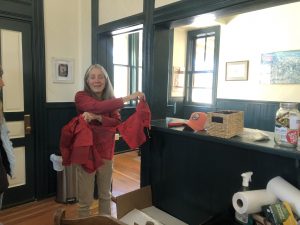By Mitchell Adams
CRESTED BUTTE—High in the Elk Mountain Range, there is no question that climate change is reshaping the environment. But, two prevalent town figures who agree on climate science are fighting for fundamentally different responses.
One wants to prioritize the preservation of the natural ecosystem, while the other wants to capitalize on global climate warming by marketing Crested Butte as an unaffected climate haven, ready for tourists and new residents.
The Intergovernmental Panel on Climate Change has predicted that we are locked into at least 2.5 degrees Celsius of warming by 2100, with worst-case projections clocking in at 4 degrees Celcius. Anything but the best-case scenario would make for a world full of climate refugees.
“I don’t have too many worries,” said John Norton, the executive director for the Gunnison-Crested Butte tourism group, and former head of Aspen Ski Company.
Crested Butte is a small outdoor-oriented town, full of ski-themed pubs, multiple bike shops, and plenty of outdoor recreation.
In the winter, Mount Crested Butte is a ski favorite that has seen a recent resurgence after being acquired by Vail Associates.
Summertime brings a deluge of mountain bikers, eager to ride on the over 750 miles of trails.
Along with recreation, Norton promotes the area’s prolific wildflowers and alpine wildlife.
As journalists arrived for an interview at Norton’s eco-friendly home, a dog still recovering from a ski-related injury, eagerly hobbled over to greet them. Norton, an avid outdoorsman in his 60s, who once was the marketing director for Proctor and Gamble, spoke to journalists on the topic of climate change in front of his warm concrete fireplace.
“I’m an optimist,” Norton said.

John Norton outside of his home in Crested Butte (Whitton Feer)
Due to Crested Butte’s almost 9,000 feet of elevation, the town will not see climate incidents that affect people, like extreme heat events, dangerous storms, or sea-level rise, any time soon.
For this reason, the town has already seen people moving in from areas like Texas, where blistering heat and extreme weather events plague residents.
Norton is not worried about a potential influx of climate immigrants.
“We are a Connecticut sized county with 15,000 people,” Norton said.
Norton promotes the lack of effect the changing climate will have on Crested Butte on the front page of the tourism website for the region.
The tourism board is focusing on attracting mountain bikers and trail runners, Norton said.
“Our engine is a tourism-based economy,” he said.
When asked about the environmental impacts that mountain biking and skiing may have, Norton said he never thought about it.

Promotion of the area on the Gunnison-Crested Butte website, advertising a care-free lifestyle
Sitting in an office that once was a train station built for exporting silver and coal, longtime resident Sue Navey, board president for the High Country Conservation Advocates discussed the need for urgency regarding climate change.
“Everybody is freaked out about it,” Navey said.
The employees and volunteers that Navey works with are addicted to “making things better,” Navey said, “everything we do has something to do with climate.”

Sue Navy, showing off prayer flags supporting conservation efforts for a beloved local mountain (Johnna Geick)
One of the biggest focuses for Navey’s organization is protecting wildlife and natural land in the area.
The Gunnison Sage Grouse is an endangered species that reside in the Gunnison Basin. They have been the focus of many local conservation advocates. There are only a few hundred birds left, due to the species’ declining habitat. This decline is attributed to an influx of recent infrastructure, like highways, and housing developments, according to the National Audobon Society.
“Some people are saying more, more, more,” Navey said.
In her 48 years living in the area, Navey has seen lots of community growth, which has been accompanied by increased use of resources.
She is concerned about tourists and locals alike “loving the backcountry to death,” and hopes the town can come together.
Another major project in the community involves volunteers placing strategic one-rock-dams, which slows stream water down, in the face of increasing erosion in arid areas. This allows stream biology to improve.
Every year, many locals get their hands dirty in order to make a difference in their own community.
In terms of the mental attitude of the community, Navey says that the town has an upbeat spirit on climate because of its proximity to beautiful spots for spending time outdoors. She thinks people find peace among the trails.
Even with an upbeat spirit, Navey’s mind is choc-full of climate thoughts.
“I’ll wake up in the middle of the night with wheels spinning.”
As locals grapple with what to do in regards to the changing climate, David Inouye, a scientist who works at the Rocky Mountain Biology Lab, sees climate change affecting local organisms every day.
Inouye is an expert on phenology, which is the study of repeated cycles that occur in nature. Currently, he sees phenology mismatches in the Crested Butte area.
For example, if snowmelt happens later in the season than it ever has before, due to climate change, hummingbirds may migrate to Colorado and be surprised to see a lack of food, Inouye said.
These mismatches are tell-tale signs that climate change is occurring, even in idyllic Crested Butte.
“We are in for an interesting ride,” Inouye said. “What’s normal now is going to change over time.”
